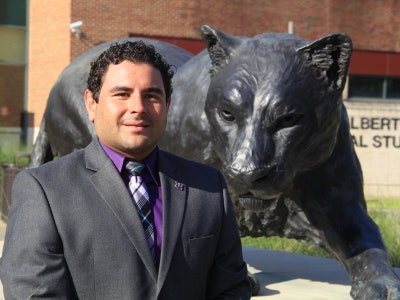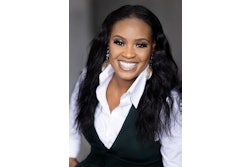 Ramiro Bautista is a Prairie View A&M University graduate and serves as the university’s assistant registrar. (Photo courtesy of Prairie View A&M University)
Ramiro Bautista is a Prairie View A&M University graduate and serves as the university’s assistant registrar. (Photo courtesy of Prairie View A&M University)Ramiro Bautista sought to accomplish two things after graduating from a two-year college in 2005. Primarily, he wanted to get into a four-year college with a reputable business program. Secondly, he wanted to be near a friend who received a full athletic scholarship to a certain university. That college turned out to be Prairie View A&M University, a historically Black college about 45 minutes northwest of Houston.
Back then, says Bautista, Latinos were a miniscule presence on the campus, accounting for less than 3 percent of the student body. Since fall 2000, growth of Latinos on campus has been more than 230 percent, according to the university. Despite a small drop during the last academic year, Latinos make up more than 5 percent of the population.
“When I came here in 2005 the outreach wasn’t there,” says Bautista, who stuck around after graduation in 2007 to get his MBA, is currently pursuing his doctorate there and serves as the university’s assistant registrar. “For the last three to five years, the university has been targeting markets with heavy populations of Latinos. As a result, there’s been a steady increase in the number of Latinos.”
For several years, he says, the university employed a full-time recruiter, a Latino who was also an alumnus and whose primary responsibility was attracting Latino prospects.
He says that A&M has also introduced a Direct Connect Program aimed at community college students looking to transfer to a four-year university. Based on the terms of the Direct Connect Program, students from Texas public community colleges with associate degrees who are U.S. citizens and residents of Texas may transfer to Prairie View A&M University and are eligible to pay the same fixed tuition and mandatory fees rate, at the time of registration, as that of their prior institution. These students will also receive a Direct Connect Tuition Assistance Scholarship to offset the cost.
Diversity at HBCUs
Diversity is increasingly becoming a priority for many historically Black colleges. In recent years, many have worked diligently to attract international students as well as students of other races and ethnicities, especially Latinos.
This is particularly true in states that have high numbers of Latinos, such as Texas.
Some higher education experts say that the mission of HBCUs to serve the historically disenfranchised strikes a chord with Latinos.
Dr. Deborah Santiago, chief operating officer and vice president for policy at Excelencia in Education, a Washington, D.C.-based advocacy group that promotes the interests of Latinos in higher education, says that HBCUs generally tend to be more student focused and have faculty who are culturally competent, making them attractive to emerging populations such as Latinos.
That’s a view echoed by Dr. Marybeth Gasman, a professor of higher education at the University of Pennsylvania.
“HBCUs often have family environments and Latinos feel more comfortable in these environments,” she says, adding that HBCUs generally have lower tuition and that this appeals to Latinos, many of whom come from lower-income families.
Adds Dr. Jerry Crawford, an associate professor of journalism at the University of Kansas, who has done extensive research on HBCUs, “Ever since the 1890s, their mission has always been to educate the underserved. Most people equate HBCUs with African-Americans. However, many times HBCUs took [other] people of lower socioeconomic status.”
The ability to recruit Latinos, he says, is even more critical today as more colleges operate as businesses and those who fail to do so go belly up. Latinos, he says, are a potentially bountiful market for all colleges, including HBCUs.
“More and more Hispanics are becoming aware of filling out Pell Grants,” Crawford says. “More are becoming college eligible. More universities are allowing students who don’t have full documentation to enter college.”
Santiago says that it is in the best interest of HBCUs to recruit Latinos.
Latino enrollment
“The reality is the number of Latinos eligible to go to college has increased,” says Santiago. “There is an awareness of that. HBCUs have found ways to try to be more competitive. They are being smart. Their survival can depend on recruiting more students and widening their base. Given the precarious situation of some HBCUs, their future could depend on their ability to attract these students.”
Linda Jackson, director of university relations for Huston-Tillotson University in Austin, Texas, an institution that has seen 14 years of consecutive enrollment growth, says 19 percent of the approximately 1,030 students in 2010 were Latino, compared to 10 percent in 2004. She says Latino enrollment has hovered at around 19 percent since 2010.
Jackson attributes the significant number of Latinos to several factors, including Texas’ large Latino population and the university’s attractive array of academic offerings. She says the university has an enrollment strategy in place aimed at targeting numerous groups, including working adults, traditional African-American students and Latinos.
At Paul Quinn College in Dallas, President Michael Sorrell says 20 percent of the incoming students this year are Latinos, up from about 15 percent last year. He says approximately 12 percent of the student body is Latino.
Sorrell, who’s been president for eight years, says that, in addition to Texas, the students come from many other locales around the country, including Detroit, Chicago, New York and California.
He insists that Paul Quinn doesn’t recruit students based on race or ethnicity, but on whether they are a fit for the college’s values, which include placing the team above the individual.
“I always found it distasteful when schools recruited me because I’m Black,” says Sorrell, a Duke University-trained attorney. “I don’t want to be your diversity experience. To me, there’s a higher level of sincerity when people view me as more than just a skin color.”
That said, his senior recruiter, a graduate of the college, is Latina. “She wasn’t hired for any reason other than the fact that she’s good,” he says.
Sorrell adds that Paul Quinn entices students for other reasons, including the fact that the students receive a vigorous liberal arts education, earn professional work experience in their last two years and typically graduate with no more than $10,000 in debt.
Experts say that it’s too early to say how the influx of Latinos is transforming the culture of HBCUs, but they say they’ve been quick to notice changes such as the emergence of Latino fraternities and sororities.
Bautista says that, at Prairie View A&M, he’s seen a heightened participation in student life by Latinos. He says several Latinos hold student leadership positions. One pledged the historically Black sorority Alpha Kappa Alpha. Another, a student-athlete, was crowned Miss Puerto Rico and will be representing the commonwealth in the Miss America pageant. Many Latino cultural events, such as Day of the Dead, a Mexican festival that honors ancestors, now dot the student life calendar.
Sorrell says that, at Paul Quinn College, administrators have worked to mesh the cultures. An academic year kick-off event early in August, for example, featured dishes from both African-American and Latino cultures.
Pushback at colleges
But not everyone has been quick to embrace the changes at some of these HBCUs.
Chad Dion Lassiter, an alumnus of Johnson C. Smith College in Charlotte and a member of the Board of Trustees of the Community College of Philadelphia, says that sometimes there is pushback from alumni who fear that the heritage of the institution may be eroded by the influx of Latino students.
“During homecoming, I may get an alum saying, ‘So why does this Hispanic guy or girl want to go here?’” says Lassiter, a social worker who also teaches at West Chester University and the University of Pennsylvania. “I don’t think they understand that it is a similar population. It is xenophobia. They think something is going to get lost. One in particular said, ‘Why don’t they go to their own universities?’ I said, ‘That right there is irrational hatred. Why not open our doors to a group that has been similarly marginalized and oppressed?’
“The pushback comes from ignorance and xenophobia and not fundamentally understanding who’s coming and celebrating differences and not losing your mission as you do it. Ultimately we learn more about ourselves as we interact with [other] people of color. It enriches the university environment and the overall culture. It has the potential to enrich us and ultimately that is the greatest form of liberation. I think we’re better because of our interaction with Hispanic people.”
Santiago says change in higher education can be difficult. She notes that some at predominantly White institutions have expressed concerns when those colleges became designated Hispanic-serving institutions.
As she says, “There’s always concern that mission creep will dilute the integrity of the institution and its initial purpose.”
But Crawford says that the reality is, for HBCUs to survive in the 21st century, they must do business differently. And doing business differently means aggressively going after all students, he says.
“St. Paul’s in Virginia was shuttered last year because [the school] couldn’t come up with $5 million,” he says. “It’s important that these HBCUs understand that their mission is supposed to be to educate people, but to do that you have to have accredited programs. These schools should not struggle. There are enough first-generation students to go around.”















